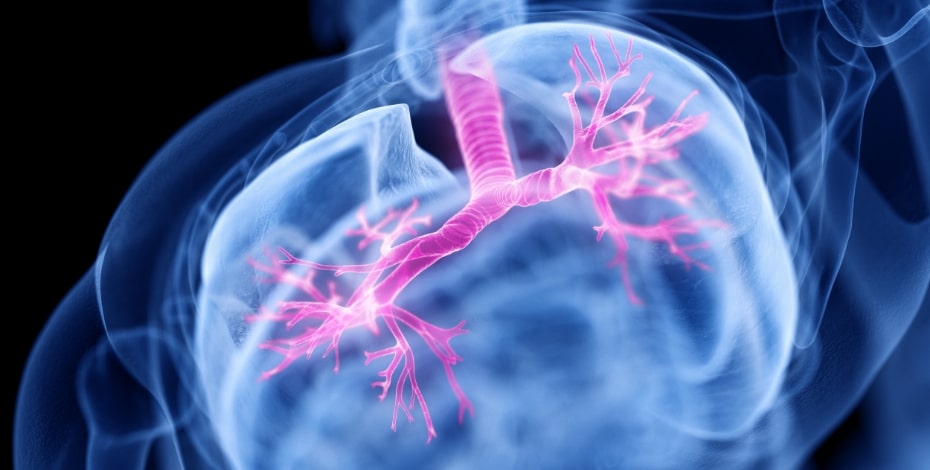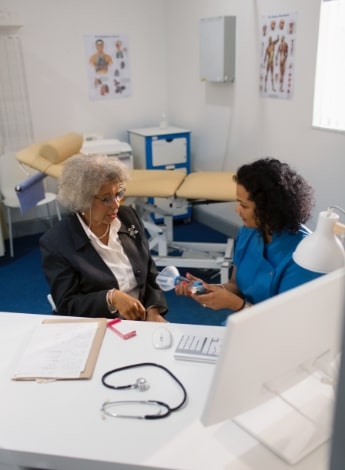
The role of physiotherapy in chronic asthma

To coincide with World Asthma Day 2022, Sonia Cheng and Mitchell Taylor from the APA Cardiorespiratory national group present five discussion points about the role of physiotherapists in the management of chronic asthma.
1. The treatable traits approach improves patient outcomes in chronic asthma

Identifying the treatable traits of a patient with chronic asthma through a comprehensive assessment improves outcomes.
The treatable traits model is a new paradigm in the management of chronic asthma.
Rather than using a one-size-fits-all treatment approach, clinicians should undertake a comprehensive patient assessment that aims to identify the individual’s treatable traits (McDonald et al 2019).
Several specific traits have been identified in asthma, including allergies, eosinophilia, upper airway disease, sarcopaenia, osteopaenia, dysfunctional breathing, depression and anxiety, poor inhaler technique, obesity, mucus hypersecretion and low confidence with exercise.
Some treatable traits are best managed by a respiratory physician (eg, eosinophilia), while other traits require involvement from physiotherapists and the wider multidisciplinary team.
The use of a treatable traits model in severe asthma has been shown to improve health-related quality of life and asthma control and to reduce healthcare use (McDonald et al 2020).
2. Sarcopaenia and osteopaenia can be addressed with regular exercise and physical activity
Sarcopaenia, activity limitation and low confidence to engage in physical activity (PA) are common extrapulmonary treatable traits in chronic asthma.
This population is at higher risk of osteopaenia due to prolonged use of inhaled corticosteroids (Kumarathas et al 2020), which may lead to osteoporotic fractures.
Obesity is also an important risk factor and disease modifier in asthma.
Obesity increases the risk of developing asthma and people with asthma who are also obese have more frequent and severe exacerbations and reduced response to several medications (Peters et al 2018).
Pulmonary rehabilitation is the optimal setting for addressing sarcopaenia and osteopaenia and promoting weight loss.
Aerobic training should be performed at ≥60 per cent of peak work rate in an incremental exercise test for 20–30 minutes, 3–5 times a week, to increase endurance capacity and reduce dyspnoea (Nici et al 2006).
Resistance training involving the major muscle groups should be performed at 8–10 repetitions for a maximum 2–3 times a week (Ries et al 2007).
People with asthma should be supported through PA counselling and the provision of feedback on objectively measured PA to adhere to current PA recommendations, which include 150–300 minutes a week of moderate-intensity aerobic PA, and PA that emphasises functional balance and muscle strengthening activities at least three times a week to reduce falls risk (World Health Organization 2020).
Resistance and balance training in conjunction with bisphosphonate therapies are recommended to increase bone strength (RACGP & Osteoporosis Australia 2017).
3. Dysfunctional breathing is a common, but often undiagnosed, treatable trait
Dysfunctional breathing, or breathing pattern disorders, occurs when a change in breathing mechanics manifests itself as self-perpetuating respiratory symptoms such as breathlessness, chest pain and an inability to get a satisfying breath.

Physiotherapy management of dysfunctional breathing, which has a significant overlap with chronic asthma, can improve symptoms and quality of life.
Dysfunctional breathing was thought to be a differential diagnosis to asthma; however, recent research has highlighted the significant overlap between the two conditions, with poorly controlled asthma often being a driver of the development of dysfunctional breathing.
The prevalence of dysfunctional breathing in chronic asthma is estimated to be 29–64 per cent, with a higher prevalence in those with severe asthma (Courtney et al 2017).
People with chronic asthma who develop dysfunctional breathing may have symptoms of breathlessness disproportionate to their underlying disease and symptoms that do not respond to traditional therapies (Veidal et al 2017).
Regular screening for dysfunctional breathing in severe asthma is important to improve early identification and onward referral to appropriately trained physiotherapists for breathing retraining exercises (RACGP & Osteoporosis Australia 2017).
Physiotherapy and breathing retraining are at the core of dysfunctional breathing management, which has been shown to improve symptoms and health-related quality of life (Courtney et al 2017).
4. Ensuring good inhaler technique is everyone’s responsibility
Inhaled corticosteroid-based preventers are the foundation of medical management for asthma and are prescribed for all adults who report asthma symptoms twice or more during the past month, waking due to asthma symptoms once or more during the past month or an asthma flare-up in the previous 12 months (National Asthma Council Australia 2020).

Inhaler technique should be reviewed by all health professionals treating chronic asthma, including physiotherapists, to ensure patients are using inhalers correctly.
There has been a recent shift away from an over-reliance on relievers containing a rapid-onset beta2-agonist.
Use of reliever medications alone is associated with an increased risk of severe flare-ups in the absence of inhaled corticosteroids or with poor adherence to inhaled corticosteroids (Mauer & Taliercio 2020).
It is critical to train patients in how to use their inhaler correctly, including the use of a spacer, via physical demonstrations or videos.
Poor adherence with inhalers and inhaler technique errors significantly undermine the efficacy of these medications.
Up to 87 per cent of patients make at least one technique error when using their inhalers (Castel-Branco et al 2017).
Current guidelines recommend reviewing inhaler technique at all points of contact with health professionals, including with physiotherapists (Mauer & Taliercio 2020).
Lung Foundation Australia and National Asthma Council Australia have a range of resources to assist physiotherapists in reviewing inhaler device polypharmacy and poor inhaler technique, including the Asthma and COPD Medications Chart, inhaler technique checklists, demonstration videos and asthma action plans.
5. The need for airway clearance should be assessed in all patients with chronic asthma
Mucus hypersecretion is a common treatable trait in chronic asthma and may lead to retained secretions and an increased risk of respiratory infections.
An estimated 30 per cent of people with chronic asthma develop bronchiectasis (Padilla-Galo et al 2018), which can further worsen mucus hypersecretion and mucus stasis in the lungs.
Patients identified with mucus hypersecretion, defined as the production of >25 ml of sputum per day, should be referred to an appropriately trained physiotherapist for prescription of an airway clearance routine.
Patients should be provided with a range of airway clearance techniques to identify the most practical and effective strategy with high compliance (Belli et al 2021).
The forced expiratory technique in an appropriate postural drainage position is recommended for all individuals with self-reported cough and sputum, and the active cycle of breathing and oscillatory positive expiratory pressure devices for those with bronchiectasis (Hill et al 2019).
Mucolytics, including humidification and saline nebulisation, may be beneficial for individuals with difficulty expectorating sputum.
Patients should be followed up within three months to assess the effectiveness of the airway clearance routine and to modify their routine if needed, including the addition of other techniques and increasing daily airway clearance frequency.
Click here for an infographic poster version of this article.
>> Mitchell Taylor APAM is the director and lead physiotherapist at Functional Lungs Respiratory Physiotherapy and deputy chair of the Cardiorespiratory New South Wales chapter committee. He is a clinical researcher in the Department of Respiratory Medicine at St George Hospital, Sydney and conducts a number of practitioner courses with a focus on cardiorespiratory physiotherapy in private practice.
>> Sonia Cheng APAM is a cardiorespiratory physiotherapist and lecturer with the Discipline of Physiotherapy at the University of Sydney. She is the chair of the APA Cardiorespiratory national group. Her research interests include the measurement and promotion of physical activity in people with chronic disease.
- References
McDonald VM, Fingleton J, Agusti A, et al. Treatable traits: a new paradigm for 21st century management of chronic airway diseases: Treatable Traits Down Under International Workshop report. Eur Respir J. 2019 May 9;53(5):1802058. doi: 10.1183/13993003.02058-2018.
McDonald VM, Clark VL, Cordova-Rivera L, et al. Targeting treatable traits in severe asthma: a randomised controlled trial. Eur Respir J. 2020 Mar 5;55(3):1901509. doi: 10.1183/13993003.01509-2019.
Kumarathas I, Harsløf T, Andersen CU, et al. The risk of osteoporosis in patients with asthma. Eur Clin Respir J. 2020;7(1):1763612. Published 2020 May 19. doi:10.1080/20018525.2020.1763612.
Peters U, Dixon AE, Forno E. Obesity and asthma. J Allergy Clin Immunol. 2018;141(4):1169-1179. doi:10.1016/j.jaci.2018.02.004.
Nici L, Donner C, Wouters E, et al. American Thoracic Society/European Respiratory Society statement on pulmonary rehabilitation. Am J Respir Crit Care Med. 2006 Jun 15;173(12):1390-413. doi: 10.1164/rccm.200508-1211ST.
Ries AL, Bauldoff GS, Carlin BW, et al. Pulmonary Rehabilitation: Joint ACCP/AACVPR Evidence-Based Clinical Practice Guidelines. Chest. 2007 May;131(5 Suppl):4S-42S. doi: 10.1378/chest.06-2418.
WHO guidelines on physical activity and sedentary behaviour. Geneva: World Health Organization; 2020. Licence: CC BY-NC-SA 3.0 IGO.
The Royal Australian College of General Practitioners and Osteoporosis Australia. Osteoporosis prevention, diagnosis and management in postmenopausal women and men over 50 years of age. 2nd edn. East Melbourne, Vic: RACGP, 2017.
Courtney R. Breathing training for dysfunctional breathing in asthma: taking a multidimensional approach. ERJ Open Res. 2017;3(4):00065-2017. Published 2017 Dec 8. doi:10.1183/23120541.00065-2017.
Veidal S, Jeppegaard M, Sverrild A, et al. The impact of dysfunctional breathing on the assessment of asthma control. Respir Med. 2017 Feb;123:42-47. doi: 10.1016/j.rmed.2016.12.008. Epub 2016 Dec 18.
National Asthma Council Australia. Australian Asthma Handbook, Version 2.1. National Asthma Council Australia, Melbourne, 2020. Website. Available from: http://www.asthmahandbook.org.au.
Castel-Branco MM, Fontes A, Figueiredo IV. Identification of inhaler technique errors with a routine procedure in Portuguese community pharmacy. Pharm Pract (Granada). 2017 Oct-Dec;15(4):1072. doi: 10.18549/PharmPract.2017.04.1072. Epub 2017 Dec 18.
Mauer Y, Taliercio RM. Managing adult asthma: The 2019 GINA guidelines. Cleve Clin J Med. 2020 Aug 31;87(9):569-575. doi: 10.3949/ccjm.87a.19136.
Padilla-Galo A, Olveira C, Fernández de Rota-Garcia L, et al. Factors associated with bronchiectasis in patients with uncontrolled asthma; the NOPES score: a study in 398 patients. Respir Res. 2018;19:43. doi: 10.1186/s12931-018-0746-7.
Belli S, Prince I, Savio G, et al. Airway Clearance Techniques: The Right Choice for the Right Patient. Front Med (Lausanne). 2021;8:544826. Published 2021 Feb 4. doi:10.3389/fmed.2021.544826.
Hill AT, Sullivan AL, Chalmers JD, et al. British Thoracic Society Guideline for bronchiectasis in adults. Thorax 2019;74:1-69. doi: 10.1136/thoraxjnl-2018-212463.
© Copyright 2025 by Australian Physiotherapy Association. All rights reserved.





